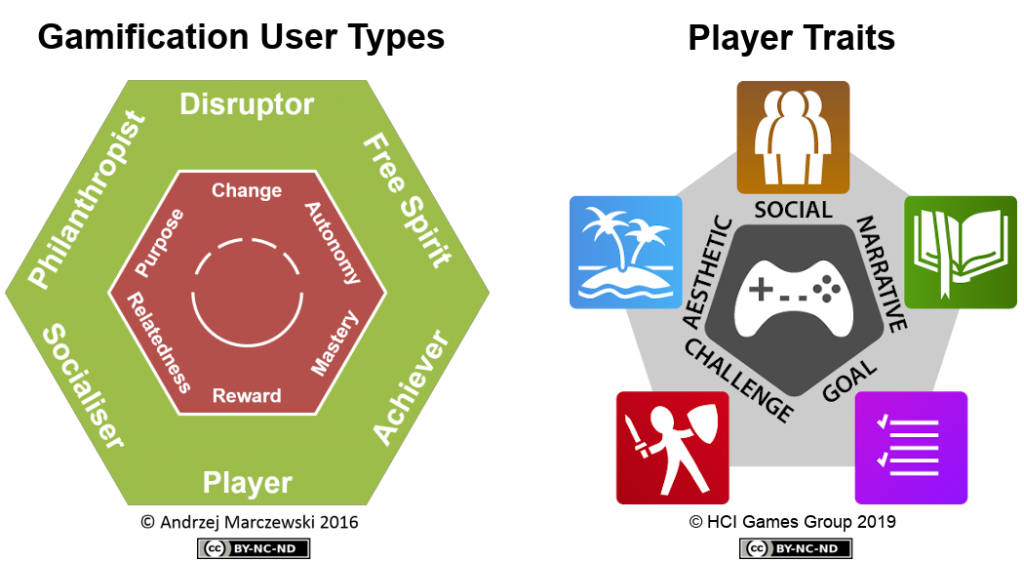At the HCI Games Group, we have been working for the past few years on two related projects: the validation of the Gamification User Types Hexad and the study of player typologies, which recently led to the creation of our Five-factor Player Traits model. Therefore, a question that people have been asking us is when they should use each one of these models. Are they interchangeable, or are there specific situations when one is more appropriate than the other?
Short answer: we recommend using the User Types Hexad when you are working on a gamification project (meaning the design of a gameful application or experience), but using the Player Traits when you are working on a game project (meaning the design of a full-fledged game, no matter if it is just for entertainment or if it also has an instrumental purpose).

Of course, there are many similarities between gameful design and game design, as both aim to create gameful experiences (Landers et al., 2019). Both design approaches utilize similar sets of elements and mechanics, such as points, leaderboards, quests, levels, avatars, stories, trading, virtual economy, and many others. But the main difference is that the gameful elements and activities are just a part of the user journey in gameful applications because the user is also carrying out activities that are not just game elements, such as completing educational lessons, doing fitness activities, keeping track of their health, accomplishing business goals, or purchasing products from a specific brand, just to cite a few of the common applications of gamification. In contrast, in a full-fledged game, all the activities are part of the gameplay, even when they have a goal that goes beyond pure entertainment, like education, brand awareness, etc.
Some people argue that this difference does not matter. I say it depends. For the client or business, it often does not matter indeed. Accomplishing the chosen goals and having an adequate return of investment will be much more important for them than what is the exact design approach employed to achieve the goals. However, I think it is important for the designers creating these experiences to understand the subtle differences between them, and in this case, how they relate to different models of user or player preferences.
In our experience, the way that people differentiate what they prefer in gameful applications and games is not the same. This happens because the role of game elements in the experience is different: in gameful applications, the game elements are only part of the experience, whereas they are the whole experience in a game. Consequently, I prefer using the word user when talking about gameful applications because there will be some activities that are not directly related to gameplay. But I say player when talking about games because interaction with a game is always gameplay (unless it involves some metagame layer like achievements or chat, but then the person is not interacting with the game directly, it is another application layer built on top of the game).
Therefore, we at the HCI Games Group believe that it is necessary to separately study individual preferences in gameful applications or games. The Gamification User Types Hexad was created by Marczewski specifically for gamification and aims to capture different ways that users typically interact with this kind of application. On the other hand, we developed the Player Traits by specifically asking what people enjoy doing in games, so they better represent different playing styles.
Is it possible to use these models interchangeably? Would the Gamification User Types be also useful to design a game, or the Player Traits still be useful to design a gameful application? Probably, yes. However, I believe that they will be less effective than using the correct model. There is enough similarity between gameful design and game design, so the incorrect model is not completely useless. But each one of the models is better suited to capture the subtle differences in each context better than the other. These user/player preference models have already simplified individual preferences so we can better understand them, but any time we try to group people in categories, we lose a bit of the information about individual preferences. If on top of that we use a model that is not the best for the context we are working on, we lose even more of the model’s potential to accurately represent the reality of our users/players.
Do we have evidence that each model works better in the context for which they were designed? Unfortunately, we do not have enough scientific evidence yet, but we and other research groups are working on it. We collected a lot of data about user/player preferences in recent years for the development and validation of our models and we did look at all the data to see if there were correspondences between the models and how well they were related to individual preferences. Of course, some types are related, such as the Socialiser gamification user type and the Social-orientation trait, but other classifications are not related. On the other hand, these initial analyses suggested that the gamification user types are better related to individual preferences for different game elements in gameful applications than the player traits and vice-versa. However, because this comparison was not the goal of the studies we conducted so far, these results are not published yet. We are currently collecting additional data for a new study in which we will explicitly make this comparison and we expect to be able to show that the user types work better for modelling user preferences in gamification, whereas the player traits work better for modelling player preferences in games. If you want to contribute to our research, please fill out our survey and invite other people to also do it!
Of course, some designs may fall within a borderline, making it difficult to classify the resulting product into a game or a gameful application. If it is not clear if something is a game or a gameful application, the designer will have to use their best judgment to choose one of the models. However, when the classification of the product is clear, we strongly suggest using the User Types Hexad for gameful applications and the Player Traits for games.
Also published by the HCI Games Group on Medium.



